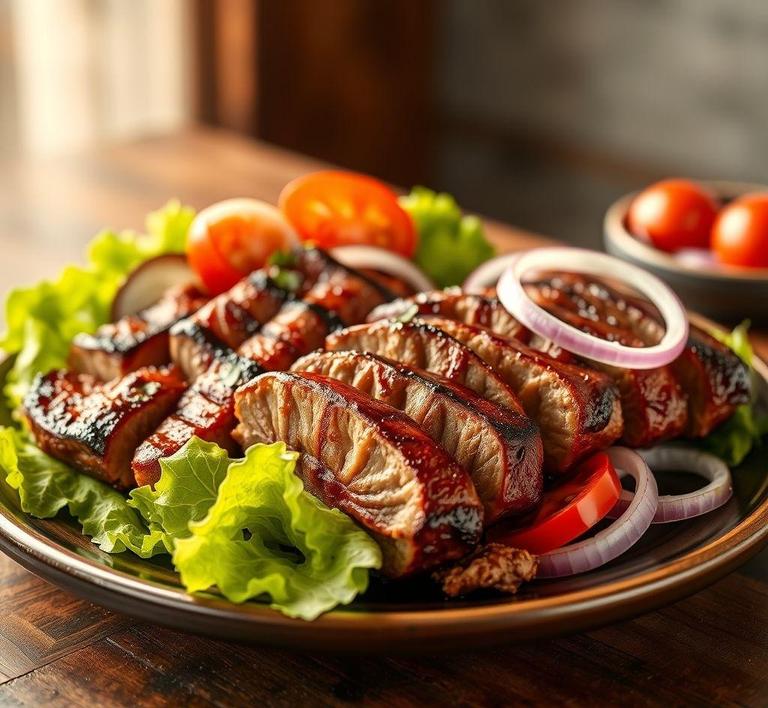If you’re a fan of gyro meat, you probably know how important it is to store it properly to maintain that perfect flavor and texture. But what if you’ve got leftovers or bought a bit too much? Can you refreeze gyro meat without compromising its deliciousness? Absolutely! Refreezing gyro meat is a handy way to reduce food waste and keep your meals ready for the next craving. However, there are a few tips and tricks to ensure that the meat retains its juiciness and flavor when reheated. Let’s dive into how to safely refreeze gyro meat and preserve that mouthwatering taste you love!
Can You Refreeze Gyro Meat?

Gyro meat, a succulent blend of seasoned lamb, beef, or sometimes chicken, is beloved for its rich flavor and tender texture, typically cooked on a vertical rotisserie. When it comes to refreezing gyro meat, the question is more than just a yes or no-it’s a matter of food safety, texture, and flavor preservation.
Food Safety Considerations:
The most critical factor in determining if gyro meat can be refrozen hinges on whether it has been thawed properly and how long it has been left at room temperature. According to USDA guidelines, meat that has been thawed in the refrigerator and kept at safe temperatures (below 40°F or 4°C) can generally be refrozen without risking foodborne illness. However, if the gyro meat has been thawed at room temperature for more than two hours-or one hour in temperatures above 90°F (32°C)-it is unsafe to refreeze, as harmful bacteria may have begun to multiply.
Commercially Frozen vs. Cooked and Thawed:
If you purchased gyro meat frozen and never thawed it fully, or only thawed it partially but kept it refrigerated, refreezing is usually safe. But if the meat has already been cooked, served, and then refrigerated, refreezing is more of a gray area. While safe if handled properly, repeated freezing and thawing cycles can degrade the meat’s texture and flavor.
In summary: You can refreeze gyro meat if it has been thawed in the fridge and hasn’t sat out too long. But caution must be exercised to avoid food safety risks and undesirable quality degradation.
How To Refreeze Gyro Meat?
When you decide to refreeze gyro meat, doing it right is essential to maintain safety and preserve as much of the meat’s delicious characteristics as possible. Here’s a detailed step-by-step guide:
-
Check the Meat’s Condition:
Before refreezing, inspect the gyro meat visually and by smell. If there’s any off-putting odor, sliminess, or discoloration, discard it. Freshness is paramount.
-
Cool the Meat Properly:
Ensure the gyro meat is completely cooled if it was recently cooked or reheated. Putting warm meat directly into the freezer promotes ice crystals formation, which harms texture.
-
Use Airtight Packaging:
Wrap the gyro meat tightly in plastic wrap or aluminum foil, then place it inside a freezer-safe resealable bag or vacuum-seal if possible. Minimizing exposure to air reduces freezer burn and moisture loss.
-
Label and Date:
Clearly mark the packaging with the date of refreezing. Ideally, use within 1 to 2 months for best flavor and texture.
-
Freeze Quickly:
Place the gyro meat in the coldest part of your freezer to freeze it as quickly as possible. Faster freezing means smaller ice crystals, which protect texture.
-
Thaw Properly Next Time:
When ready to use again, thaw gyro meat slowly in the refrigerator rather than at room temperature. This maintains safety and preserves quality.
Quality Impact
Refreezing gyro meat inevitably affects its sensory qualities, and understanding this impact is important if you care about enjoying your gyro at its best.
Texture Changes:
Meat fibers contain water, and freezing causes this water to turn into ice crystals. During freezing, these crystals puncture muscle cells. Upon thawing, moisture leaks out, resulting in dryer, tougher meat. With each freeze-thaw cycle, the damage accumulates, and gyro meat can become noticeably less juicy and tender.
Flavor Degradation:
Gyro meat is seasoned and cooked with specific spice blends and marinades that give it its characteristic taste. Refreezing can cause subtle changes in flavor due to oxidation and moisture loss. The spices may lose some intensity, and the overall savory profile might seem muted.
Visual Appeal:
Repeated freezing can lead to freezer burn-a dehydrated, discolored patch on the surface of meat caused by exposure to air. While freezer-burned meat is safe to eat, it tastes unpleasant and can appear grayish or whitish.
Nutritional Value:
While minimal, some nutrient loss occurs with freezing and refreezing. Protein remains largely intact, but water-soluble vitamins may diminish slightly.
Refreezing gyro meat is a practice that walks a fine line between convenience and quality compromise. If done safely-ensuring the meat was thawed properly and refrigerated-refreezing can be a practical option to reduce waste and extend shelf life. However, each freeze-thaw cycle will impact the texture, flavor, and visual appeal of the meat, potentially detracting from the luscious, tender qualities that make gyro meat so delicious.
For best results, only refreeze gyro meat once, keep it tightly sealed to prevent freezer burn, and consume it within a month or two. When thawing, always use the refrigerator method to maintain food safety. Ultimately, while refreezing is feasible, planning your portions and storage upfront can help you enjoy gyro meat at its peak, juicy, and flavorful every time.
Is It Safe To Refreeze Gyro Meat?
Gyro meat-succulent slices of seasoned lamb, beef, or a mix, traditionally slow-roasted on a vertical spit-is a beloved staple in Mediterranean cuisine. But what happens if you have leftover gyro meat and wonder about refreezing it?
The short answer: refreezing gyro meat can be safe, but it depends heavily on how the meat was handled before and after the initial thaw.
When gyro meat is cooked and immediately frozen, it maintains a high level of safety because freezing halts bacterial growth. However, once thawed, the environment becomes more vulnerable to bacteria multiplication. If gyro meat has been thawed but left at room temperature too long or partially cooked and then refrozen, refreezing could trap bacteria or compromise texture and flavor.
The USDA advises that food thawed in the refrigerator can be refrozen safely without cooking, although some quality loss may occur. However, if gyro meat was thawed using quicker methods-like the microwave or cold water-and not cooked right away, refreezing is discouraged. Bacteria multiply quickly at temperatures between 40°F and 140°F (the ‘danger zone’), increasing the risk of foodborne illness.
In sum, refreezing gyro meat is safest if it was thawed in the refrigerator and has not sat out for more than two hours. When refrozen promptly under safe conditions, you protect both taste and safety.
Signs That Gyro Meat Should Not Be Refrozen
Knowing when not to refreeze gyro meat is critical to avoid health risks and food waste. Look for these key warning signs before deciding to refreeze:
- Unpleasant Odor: A sour, rancid, or ammonia-like smell signals spoilage. If the meat emits any off-putting aroma, don’t risk refreezing it.
- Slimy or Sticky Texture: Fresh gyro meat should be firm and moist, not slimy or tacky. Slime indicates bacterial growth, so refreezing would be unsafe.
- Discoloration: Grayish, greenish, or dark brown patches are a visual cue of meat deterioration. Healthy gyro meat has a rich, reddish-brown or pink hue (depending on seasoning and cooking).
- Time Left at Room Temperature: If the gyro meat was left out for over two hours at room temperature-or one hour in very warm environments-harmful bacteria likely multiplied. Refreezing under these conditions can cause illness.
- Excess Moisture or Frost Crystals: If thawed gyro meat has excessive water or frost crystals on the surface, it suggests repeated freeze-thaw cycles, damaging texture and increasing bacterial risk.
Common Refreezing Mistakes
Many people unintentionally make mistakes when refreezing gyro meat, which jeopardizes both safety and flavor. Here are some pitfalls to avoid:
- Refreezing Meat Left Out Too Long: Leaving meat at room temperature for hours before refreezing promotes bacterial growth, increasing foodborne illness risk.
- Refreezing Without Proper Cooling: Hot or warm gyro meat should never be frozen immediately. It must be cooled quickly in the refrigerator to prevent bacterial growth before freezing again.
- Using Poor Packaging: Improperly sealed or non-airtight containers allow freezer burn and contamination. This damages flavor and texture, making gyro meat dry and unpleasant.
- Repeated Freeze-Thaw Cycles: Constantly refreezing and thawing meat breaks down muscle fibers and moisture retention, causing a dry, chewy final product.
- Refreezing Partially Cooked Meat: If gyro meat was only warmed or partially cooked after thawing, refreezing can trap bacteria that were not fully destroyed by heat.
Tips And Tricks
Maximize the safety, taste, and longevity of your gyro meat with these savvy tips:
- Freeze in Small Portions: Store gyro meat in meal-sized portions so you only thaw what you need, reducing waste and avoiding multiple freeze-thaw cycles.
- Use Vacuum Sealing: Vacuum sealing gyro meat removes excess air, dramatically reducing freezer burn and preserving flavor and texture.
- Label and Date Packages: Always write the date of freezing on packaging so you keep track of freshness. Consume within 2-3 months for optimal quality.
- Thaw Safely in the Fridge: Plan ahead to thaw gyro meat in the refrigerator overnight. This method keeps the meat at safe temperatures and preserves moisture.
- Cook Immediately After Thawing: Once thawed, use or cook the gyro meat promptly. If you have leftovers, cool and freeze within two hours to maintain safety.
- Reheat Thoroughly: When reheating, bring the gyro meat to an internal temperature of 165°F (74°C) to kill any potential bacteria that might have grown during storage.
Conclusion
Refreezing gyro meat is a delicate balance of food safety and quality preservation. When done correctly-thawed in the refrigerator, handled hygienically, and frozen promptly-refreezing can be safe and convenient. However, the risks rise sharply if gyro meat is left out too long, shows signs of spoilage, or has been mishandled.
By understanding the science behind meat safety, avoiding common mistakes, and employing smart freezing and thawing techniques, you can enjoy your gyro meat without worry. Remember, when in doubt, it’s always better to err on the side of caution. Proper food handling protects your health and ensures that every bite of gyro is as delicious as it should be.


